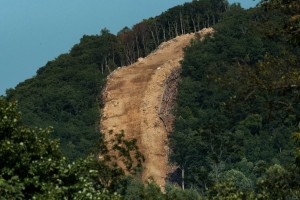From an Essay by Jacob Hileman, Virginia Mercury, August 22, 2019
On Augugust 8, Mountain Valley Pipeline requested “emergency authorization” from the Federal Energy Regulatory Commission to repair an eight-acre landslide that “has progressed to the point where a residence directly downslope is unsafe to be occupied.”
Unfortunately, events like this are almost expected; MVP chose to route, and FERC chose to approve, this titanic 42-inch diameter, 303-mile pipeline across several hundred of miles of “high landslide potential” areas.
While MVP is not the first pipeline to cross unstable terrain, nor the first pipeline to be located in landslide-prone Appalachia, is MVP actually any different from previously built pipelines?
The answer is an unequivocal “yes.”
In fact, it appears MVP has the notoriety of crossing more miles of high-risk terrain than any other major natural gas transmission pipeline in the past two decades. And perhaps ever.
Since 1997, FERC has approved no fewer than 46 new natural gas mega-pipelines, defined here as pipelines that are at least 24 inches in diameter, more than 100 miles long, and not installed along pre-existing utility corridors.
A review of the landslide hazard information contained in the environmental impact statements (EIS) for this set of pipelines reveals 22 of them – almost half – do not traverse any high landslide risk areas at all. The remaining 24 pipelines cross anywhere from 0.2 to more than 200 miles of high risk terrain.
Out of all these mega-pipeline projects, MVP finds itself infamously at the top of the list, having routed 225 miles of the pipeline – 74 percent of its total length – across high landslide risk terrain.
Considering its closest neighbors on this list, MVP is not in good company.
Just behind MVP, the 42-inch Rover Pipeline crosses 224 miles of high landslide risk areas. Yet it is a much longer pipeline; these high risk areas account for 44% of its 510-mile length. The Rover Pipeline is notoriously one of the most environmentally destructive pipelines in recent history. Last year, the pipeline was fined $430,000 for a litany of water quality violations in West Virginia due to failed sediment and erosion control devices.
Behind the Rover Pipeline comes the 42-inch Atlantic Coast Pipeline (ACP), with 187 miles crossing high landslide risk terrain. However, it is also considerably longer than MVP; these high risk areas account for only 31 percent of its 604-mile length. The ACP has had so many permits invalidated by the courts that the project is all but dead, and the underlying legal logic for these decisions also affects MVP.
Another top contender on the list is the 36-inch Leach Xpress Pipeline, with 98 miles – 74 percent of its 132-mile length – crossing high risk terrain. Five months after being placed into service, on June 7, 2018, this “best-in-class pipeline” exploded as the result of a landslide that ruptured the line.
Two weeks ago, the 36-inch Mountaineer Xpress Pipeline also marked five months of being in service, thankfully without incident. However, this pipeline has the ominous distinction of being the only project on the list to have routed fully 100 percent of its 170 miles across areas of high landslide risk.
Not coincidentally, the five pipelines highlighted here were all approved by FERC in 2017. These projects illustrate the risks the natural gas industry is willing to take to access new fracked gas supplies in the Marcellus Shale. And the risks FERC is willing to place on the shoulders of all those who live, work, go to school, or recreate in the shadow of these combustible behemoths.
It is important to note this analysis is limited to those pipelines FERC lists on its “approved major pipeline projects” webpage, which only goes back as far as 1997. This analysis also only includes those pipelines with publicly accessible EIS documentation.
However, it is likely that obtaining more data would make MVP and these other mega-pipeline projects look even more anomalous, given the relatively recent expansion of gas infrastructure through Appalachia. Ultimately, compiling and analyzing this type of comprehensive dataset is a job for FERC and other regulatory authorities, not for concerned citizens.
MVP is not a normal pipeline project, but a frightening harbinger of a new class of unconscionably high-risk pipelines. Indeed, FERC has used its “regulatory” authority to reject fewer than 1 percent of all natural gas pipeline proposals in the past 20 years.
Given landslides will remain an existential threat along the MVP right-of-way for decades to come, it is imperative Virginia regulators immediately issue a statewide Stop Work Order.
Doing so may pressure FERC into actually regulating this dangerously unprecedented pipeline.
>>> Jacob Hileman is an environmental hydrologist with a doctorate from the University of California, Davis. He was raised in the Catawba Valley of Virginia, and is presently a researcher at the Stockholm Resilience Centre working on global water sustainability issues.

